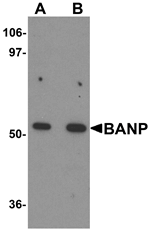BANP was initially identified as a binding protein to BTG3 in a yeast two-hybrid screen. BANP acts as a tumor suppressor by stabilizing p53 expression and leading to cell cycle arrest. p53 in turn binds to upstream elements of the BANP promoter, thereby forming a feedback loop. BANP is down-regulated in advanced stages of human breast cancer, and its overexpression in breast cancer cell lines inhibits their ability to metastasize by modulating TGF-beta signaling. Furthermore, BANP can modulate NF-κB transactivation and can inhibit tumorigenesis by regulating NF-κB target genes. Recent experiments have shown that BANP can also repress HIV-1 LTR mediated transcription by tethering the LTR matrix attachment region to nuclear matrix.


